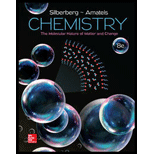
Concept explainers
(a)
Interpretation:
The reactant present in excess when
Concept introduction:
The
1. Combination redox reaction
2. Decomposition redox reaction
3. Displacement redox reactions
Combination redox reactions are the reactions in which two or more reactants combine to form a single product. In displacement redox reactions, substances on both sides of the equation remain the same but the atoms exchange places in order to form the product while in decomposition reaction, one compound decompose to form one or more product.
A limiting reagent is the one that is completely consumed in a
(a)
Answer to Problem 4.115P
The reactant present in excess when
Explanation of Solution
Lithium combines with oxygen molecule to form lithium oxide
Four moles of
The molecular mass of
The formula to calculate moles of
Substitute
The molecular mass of
The formula to calculate moles of
Substitute
The reactant present in excess concentration in reaction is
The reactant present in excess when
(b)
Interpretation:
The moles of product formed when
Concept introduction:
The redox reaction can be classified into three types depending upon the number of reactants and products as follows:
1. Combination redox reaction
2. Decomposition redox reaction
3. Displacement redox reactions
Combination redox reactions are the reactions in which two or more reactants combine to form a single product. In displacement redox reactions, substances on both sides of the equation remain the same but the atoms exchange places in order to form the product while in decomposition reaction, one compound decompose to form one or more product.
A limiting reagent is the one that is completely consumed in a chemical reaction. The amount of product formed in any chemical reaction has to be in accordance with the limiting reagent of the reaction. The amount of product depends on the amount of limiting reagent since the product formation is not possible in the absence of it.
(b)
Answer to Problem 4.115P
The moles of product formed when
Explanation of Solution
Lithium combines with oxygen molecule to form lithium oxide
Lithium is the limiting agent in the reaction.
Four moles of
The molecular mass of
The formula to calculate moles of
Substitute
The moles of product formed when
(c)
Interpretation:
The mass of each reactant and product after the reaction is to be calculated.
Concept introduction:
The redox reaction can be classified into three types depending upon the number of reactants and products as follows:
1. Combination redox reaction
2. Decomposition redox reaction
3. Displacement redox reactions
Combination redox reactions are the reactions in which two or more reactants combine to form a single product. In displacement redox reactions, substances on both sides of the equation remain the same but the atoms exchange places in order to form the product while in decomposition reaction, one compound decompose to form one or more product.
A limiting reagent is the one that is completely consumed in a chemical reaction. The amount of product formed in any chemical reaction has to be in accordance with the limiting reagent of the reaction. The amount of product depends on the amount of limiting reagent since the product formation is not possible in the absence of it.
(c)
Answer to Problem 4.115P
The mass of
Explanation of Solution
Lithium is the limiting agent in the reaction. Hence, no moles of lithium will left after the completion of reaction.
The molecular mass of
The formula to calculate mass of
Substitute
The formula to calculate mass of
Substitute
The formula to calculate mass of remaining
Substitute
The mass of
Want to see more full solutions like this?
Chapter 4 Solutions
CONNECT ACCESS CARD FOR CHEMISTRY: MOLECULAR NATURE OF MATTER AND CHANGE
- theres 2 productsarrow_forwardDraw the major product of this solvolysis reaction. Ignore any inorganic byproducts. + CH3CH2OH Drawing Q Atoms, Bonds and Rings OCH2CH3 || OEt Charges OH 00-> | Undo Reset | Br Remove Done Drag To Pan +arrow_forwardDraw the major product of this SN1 reaction. Ignore any inorganic byproducts. CH3CO2Na CH3CO2H Drawing + Br Q Atoms, Bonds and Rings OAC Charges OH ОАс Na ဂ Br Undo Reset Remove Done Drag To Pan +arrow_forward
- Organic Functional Groups entifying positions labeled with Greek letters in acids and derivatives 1/5 ssible, replace an H atom on the a carbon of the molecule in the drawing area with a ce an H atom on the ẞ carbon with a hydroxyl group substituent. ne of the substituents can't be added for any reason, just don't add it. If neither substi er the drawing area. O H OH Oneither substituent can be added. Check D 1 Accessibility ado na witharrow_forwardDifferentiate between electrophilic and nucleophilic groups. Give examples.arrow_forwardAn aldehyde/ketone plus an alcohol gives a hemiacetal, and an excess of alcohol gives an acetal. The reaction is an equilibrium; in aldehydes, it's shifted to the right and in ketones, to the left. Explain.arrow_forward
- Draw a Haworth projection or a common cyclic form of this monosaccharide: H- -OH H- OH H- -OH CH₂OHarrow_forwardAnswer the question in the first photoarrow_forwardGgggffg2258555426855 please don't use AI Calculate the positions at which the probability of a particle in a one-dimensional box is maximum if the particle is in the fifth energy level and in the eighth energy level.arrow_forward
 ChemistryChemistryISBN:9781305957404Author:Steven S. Zumdahl, Susan A. Zumdahl, Donald J. DeCostePublisher:Cengage Learning
ChemistryChemistryISBN:9781305957404Author:Steven S. Zumdahl, Susan A. Zumdahl, Donald J. DeCostePublisher:Cengage Learning ChemistryChemistryISBN:9781259911156Author:Raymond Chang Dr., Jason Overby ProfessorPublisher:McGraw-Hill Education
ChemistryChemistryISBN:9781259911156Author:Raymond Chang Dr., Jason Overby ProfessorPublisher:McGraw-Hill Education Principles of Instrumental AnalysisChemistryISBN:9781305577213Author:Douglas A. Skoog, F. James Holler, Stanley R. CrouchPublisher:Cengage Learning
Principles of Instrumental AnalysisChemistryISBN:9781305577213Author:Douglas A. Skoog, F. James Holler, Stanley R. CrouchPublisher:Cengage Learning Organic ChemistryChemistryISBN:9780078021558Author:Janice Gorzynski Smith Dr.Publisher:McGraw-Hill Education
Organic ChemistryChemistryISBN:9780078021558Author:Janice Gorzynski Smith Dr.Publisher:McGraw-Hill Education Chemistry: Principles and ReactionsChemistryISBN:9781305079373Author:William L. Masterton, Cecile N. HurleyPublisher:Cengage Learning
Chemistry: Principles and ReactionsChemistryISBN:9781305079373Author:William L. Masterton, Cecile N. HurleyPublisher:Cengage Learning Elementary Principles of Chemical Processes, Bind...ChemistryISBN:9781118431221Author:Richard M. Felder, Ronald W. Rousseau, Lisa G. BullardPublisher:WILEY
Elementary Principles of Chemical Processes, Bind...ChemistryISBN:9781118431221Author:Richard M. Felder, Ronald W. Rousseau, Lisa G. BullardPublisher:WILEY





